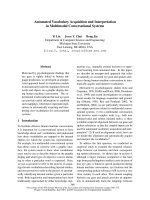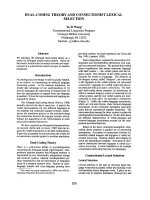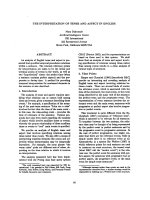Báo cáo " Formations of endogenous ore deposits and mineralization in Vietnam " doc
Bạn đang xem bản rút gọn của tài liệu. Xem và tải ngay bản đầy đủ của tài liệu tại đây (197.85 KB, 6 trang )
VNU Journal of Science, Earth Sciences 24 (2008) 26-31
26
Formations of endogenous ore deposits
and mineralization in Vietnam
Nguyen Van Nhan
College of Science, VNU
Received 14 January 2008; received in revised form 05 March 2008
Abstract. Formations of endogenous ore deposits and mineralization are widely distributed in
Vietnam. Detailed studies allow for distinguishing 30 ore formations representing 9 groups of
mineral raw - materials: Cr, Ti, Fe, Sn - W, Mo, Pb - Zn, Au, Sb - Hg. Three of presented formations
are of magmatic affiliation, one is pegmatitic, three others belong to skarn mineralization and the
remaining ones are of hydrothermal - volcanic and controversial origin. Three metallogenic epochs
can be distinguished: Proterozoic, Palaeozoic and Mesozoic - Cainozoic. Taking into consideration
the recent structural data and economic importance along with the geochemical units can be
distinguished in Vietnam: 1. Sialic - mafic Viet Bac; 2. Mafic Tay Bac; 3. Sialic Truong Son; 4. Mafic -
metamorphic Kontum; 5. Sialic - alkaline Dalat - Nam Bo.
Keywords: Endogenous ore deposit; Mineralization.
*
Vietnam and other countries of SE Asia
cover an outstanding area of the crossing of
two structural and metallogenic belts: Pacific
and Mediterranean. Simultaneously, this area
is an active continental margin Abundant and
variable ore mineralization is known with the
famous W - Sn belt and deposits of Cr, Cu, Zn
- Pb, Au, Sb - Hg, Bi, Mo and REE.
Geological history of the investigated area
is influenced by the development of the two
large adjacent structures: Southern China
platform and Indo - China fold belt. Typical
feature of Vietnam area is the Mesozoic and
Cainozoic activization structures. Numerous
intrusions ranging in age from Proterozoic to
Cainozoic were formed in tectono - magmatic
_______
* Tel.: 84-984973786.
cycles operating within the fold belts and
activated areas.
Detailed studies allow for distinguishing
30 ore formations representing 9 groups of
mineral raw - materials: Cr, Ti, Fe (Fig. 1), Sn -
W (Fig. 2), Mo, Zn - Pb, Au, Sb - Hg (Fig. 3).
Three of presented formations are of
magmatic affiliation, one is pegmatitic, three
others belong to skarn mineralization and the
remaining ones are of hydrothermal -
volcanic and controversial origin.
Three metallogenic epochs can be
distinguished: Proterozoic, Palaeozoic and
Mesozoic - Cainozoic. Archean endogenous
mineralization is poorely known but others
contain numerous, genetically diversified
magmatic and post - magmatic deposits.
Nguyen Van Nhan / VNU Journal of Science, Earth Sciences 24 (2008) 26-31
27
106
0
HANOI
Hai Phong
CHINA
20
0
Da Nang
Hue
L
A
O
S
CAMBODIA
Nha Trang
Ho Chi Minh
Can Tho
106
0
12
0
16
0
I
II
III
IV
V
0 100 200 300 km
4
5
7
1
6
9
3
8
10
2
VI VII VIII
Fig. 1. Sheme of Cr, Ti, Fe ore formations in Vietnam
Metallogenic units: I. Viet Bac; II. Tay Bac; III. Truong
Son; IV. Kon Tum; V. Da Lat - Nam Bo; VI. The Cr
ore deposits (1. Nui Nua, 2. Hon Vang); VII. The Ti
ore deposits (3. Nui Chua, 4. Tam ki, 5. Xa Hieu);
VIII. The Fe ore deposits (6. Cao Bang, 7. Ha Tinh, 8.
Trai Cau, 9. Lang Khuan, 10. Linh Nham).
During Proterozoic the area of Vietnam
was a proto - geosynclinal - proto continental
area marked by basaltoid - granitoid
magmatism. In the initial geosynclinal stage
sedimentary - volcanic pile of considerable
thickness was deposited. Basic volcanic and
meta - gabbros (ophiolite type) contain
chalcopyrite - magnetite - ortite formation
(s.c., Cu - pyrites) within metasomatic rocks
of Proterozoic basement. Pyrite and
polymetalic Cu - pyrite formations genetically
connected with basic metavolcanics
(greenschists) also belong to this stage.
Palaeozoic metallogenic epoch embraces
several ore - formations. Few ultrabasic -
basic intrusions contain Cu - Ni and Ti -
magnetite mineralization. Pegmatites related
to Late - Palaeozoic granite intrusions host
cassiterite formation with accompanying Nb
and Ta. Galena - sphalerite formation with Pb
- Sb sulphosalts is connected with granite -
grano - syenite intrusions and associated
liparite - trachites.
106
0
HANOI
Hai Phong
CHINA
20
0
Da Nang
Hue
L
A
O
S
CAMBODIA
Nha Trang
Ho Chi Minh
Can Tho
106
0
12
0
16
0
I
II
III
IV
V
0 100 200 300 km
43
39
40
VI
41
44
42
Fig. 2. Sheme of Sn - W ore formations in Vietnam.
Metallogenic units: I. Viet Bac; II. Tay Bac; III. Truong
Son; IV. Kon Tum; V. Da Lat - Nam Bo; VI. The Sn -
W ore deposits (39. Tinh Tuc, 40. Tam Dao, 41. Quy
Hop, 42. Kim Cuong, 43. Ban Chieng, 44. Phu Loi).
Nguyen Van Nhan / VNU Journal of Science, Earth Sciences 24 (2008) 26-31
28
Post - Permian rejuvenation of tectonic
and magmatic activity in the whole area of
Vietnam resulted in numerous valuable ore
and other raw - material deposits. Two
metallogenic epochs can be distinguished:
Cimmerian and Alpine.
Cimmerian epoch includes deposits and
mineralization of Fe, Cr, Cu, Ni, Pb - Zn, Mo,
Sn, W, Sb - Hg, Au - Ag. In the Black River
depression Permo - Triassic basic volcanics
are common with the related formations of
pyrites, Cu - pyrites, chalcopyrite - quartz
and native copper. Magnetite - hematite
hydrothermal - metasomatic formation can
also be connected with this basic volcanism.
Chromite formation occurs in Permo -
Triassic apo - harzburgite intrusions located
along the deep fault structure of Ma River.
Ilmenite - Ti - magnetite mineralization is
known from the widespread Upper Triassic
basic intrusions, whereas Cu - Ni formation is
hosted in Permo - Triassic serpentinized
dunites. Granite - granodiorite complexes
(Permo - Triassic) provide numerous other
formations: sphalerite - galena in carbonate
rocks, sphalerite - galena - pyrite -
arsenopyrite, and galena - quartz in granites,
magnetite in skarns and syderite.
Granodiorite - mozonite intrusions (100 - 190
my) contain molybdenite - chalcopyrite
formation. Sub - volcanic intrusions
accompanied by acid - alkaline volcanics
(Jurassic - Cretaceous) are connected with
galena - sphalerite formation with Pb - Sb
sulphosalts.
106
0
HANOI
Hai Phong
CHINA
20
0
Da Nang
Hue
L
A
O
S
CAMBODIA
Nha Trang
Ho Chi Minh
Can Tho
106
0
12
0
16
0
I
II
III
IV
V
0 100 200 300 km
28
14
22
16
25
19
21
11
VI VII VIII
35
32
24
17
12
15
34
13
29
18
33
20
30
31
27
23
26
37
38
36
IX X
Fig. 3. Sheme of Cu, Pb - Zn, Au, Sb - Hg, Mo ore
formations in Vietnam.
Metallogenic units: I. Viet Bac; II. Tay Bac; III. Truong
Son; IV. Kon Tum; V. Da Lat - Nam Bo; VI. The Cu
ore deposits (11. Sin Quyen, 12. Son La, 13. Cao Bang,
14. Tra Lam, 15. Van Sai, 16. Luong Son, 17. Nui Nua,
18. Bac Giang); VII. The Pb - Zn ore deposits (19.
Ngan Son, 20. Cho Dien, 21. Lang Hit, 22. Quan Son,
23. Mi Duc, 24. Tu Le, 25. Na Son, 26. Duc Bo, 27. Phu
Loi); VIII. The Au ore deposits (28. Bong Mieu, 29.
Pac Lan); IX. The Sb - Hg ore deposits (30. Chiem
Hoa, 31. Ba Thuoc, 32. Dien Bien, 33. Bac Thai, 34.
Yen Ve); X. The Mo ore deposits (35. Sapa, 36. Nui
Sam, 37. Krongfa, 38. Nui Dat).
Nguyen Van Nhan / VNU Journal of Science, Earth Sciences 24 (2008) 26-31
29
Alpine metallogenic epoch is
characterized by ore deposits of Sn, Mo, Zn -
Pb, Ag - Au, Sb - Bi, U and REE with the
leading deposits of Sn, W, Mo and REE.
Sphalerite - galena - cassiterite formation rich
in Ag along with Au - quartz - sulphide
formation are connected with Upper -
Cretaceous granites and leucogranites. Au -
Sb formation is spatially related to the Sn and
Zn - Pb - Ag ores. Tin deposits belonging to
cassiterite - wolframite - quartz and cassiterite
- silicate - sulphide formations are hosted in
Upper Cretaceous two - mica granites. In
Southern Vietnam quartz - molybdenite veins
cut Cretareous leucocratic - biotitic granite
massifs. Palaeogene granite - granosyenite
intrusions provide Sn and Zn - Pb ores
belonging to cassiterite - silicate - sulphide,
cassiterite and galena - sphalerite formations
in skarns, molybdenite - quartz formation
and molybdenite - uraninite one.
Table 1. Metallogenic epochs in Vietnam
Epochs Ore complex Ore formation Ore deposits
Relate to metasomatic rocks
- Chalcopyrite - magnetite - orthite
(Cu - pyrite)
Sin Quyen
PR - PZ1
Relate to green schist
- Pyrite
- Polymetalic Cu - pyrite
Bo Xinh, Duc Phu,
Duc Bo
Relate to ultramafic - mafic intrusions
- Pyrrhotite - pentlandite - chalcopyrite
- Ilmenite Ti - magnetite
Tra Lam, Dac Sa
Tam Ky, Xa Hieu
Relate to granitoid - Cassiterite in pegmatite Kim Cuong
PZ
Relate to alkaline acid extrusion
- Galena - sphalerite formation with
Pb - Sb sulphosalts
Na Son
- Pyrite Song Da
- Pyrite - Zn - Pb - Cu
- Chalcopyrit - quartz
Van Sai, Quy
Huong
- Native copper Ban Mua
Relate to basic extrusion
- Magnetite - hematite Trai Cau
Relate to apo - harzbugite - Chromite Co Dinh
Relate to dunite, gabbro, peridotite
- Pyrrhotite - pentlandite -
chalcopyrite
Ban Xang, Cao
Bang
Relate to gabbro - Ilmenite Ti - magnetite Cay Cham
- Sphalerite - galena in carbonate rock
Dien Bien
- Sphalerite - galena - pyrite -
arsenopyrite
Cho Dien
- Magnetite - hematite Thai Nguyen
- Magnetite in skarns Ha Tinh, Na Rua
- Dien Bien
- Phiabioc
- Siderite Ban Phang
Relate to granite,
grano diorit
- Van Canh
- Phu Trai
- Galena - quartz in granite
Tien Thuan, An
Khe
- Bornite - chalcocite
Bac Giang, Mau
Son
Unknown relate to magma
- Antimonite - quartz Quang Ninh
- Molybdenite - chalcopyrite Krongfa
MZ -
KZ
Cimmerian
Relate to granodiorite - mozonite
- Galena - quartz in granite Gia Bac
Nguyen Van Nhan / VNU Journal of Science, Earth Sciences 24 (2008) 26-31
30
Epochs Ore complex Ore formation Ore deposits
Relate to subpluton and alkaline acid
extrusion
- Galena - sphalerite formation with
Pb - Sb sulphosalts
Tu Le
- Cassiterite - wolframite - quartz Mepu
Relate to granite - granosyenite
- Molybdenite - wolframite Nui Dat
Relate to basanite andesite Pyrite with Au, Ag Thu Duc
- Sphalerite - galena - cassiterite
formation rich in Ag
Ngan Son
- Au - quartz - sulphide Pac Lan
- Cassiterite - wolframite - quartz Tinh Tuc
- Cassiterite - silicate - sulphide Tam Dao
- Piaoak
- Au - antimonite Chiem Hoa
Relate to granite -
leucogranite
- Deo Ca - Molybdenite - quartz Nui Sam
- Cassiterite - wolframite - quartz Bu Me
- Cassiterite - silicate - sulphide Quy Hop
Song Chu, Ban
Chieng
- Cassiterite in skarn Phu Loi
- Galena - sphalerite in skarn Ke Tang
- Molybdenite - quartz Sapa
- Molybdenite - uraninite Vi Kem
MZ -
KZ
Alpine
Relate to granite,
granosyenite
Yeyensun
- Chalcopyrite with U, REE Sin Quyen
Taking into consideration recent structural
data and economic importance along with the
geochemical character of mineralizations, five
large mineralogical units can be distinguished
in Vietnam as follows:
1. Sialic - mafic Viet Bac;
2. Mafic Tay Bac;
3. Sialic Truong Son;
4. Mafic - metamorphic Kon Tum;
5. Sialic - alkaline Da Lat - Nam Bo.
The two first units belong to Vietnam -
Chon fold belt whereas the remaining
represents Indo - China fold belt. Apart from
that, two separate zones were distinguished:
Muong Te and Ha Tien which are the parts of
Thailand - Malay geosynclinal - fold belt.
Each unit reveal typical metalogenic features
controlled by tectonic - structural development:
1. Viet Bac: Sn - W, Zn - Pb, Au, Sb - Hg;
2. Tay Bac: Cu, Cu - Ni, pyrites, Cr, Mo,
REE, Zn - Pb;
3. Truong Son: Sn - W, Zn - Pb, Fe, Au, Sb - Hg;
4. Kontum: Au;
5. Dalat - Nam Bo: Mo, Bi.
Endogenous ore - forming processes are
clearly confined to the magmatic and tectonic
activity in the specific geological epochs. The
first group embraces deposits of Cr, Ni, Co,
Cu, Cu - Ni, Fe (contact - metasomatic), Ti
and pyrites, all of them connected with
basic/ultrabasic intrusions and located along
the faults. The second group embraces
polymetallic Zn - Pb, Ag, Sb, Hg, Au, Sn - W
and rare - metal deposits genetically related
to granites and/or granodiorites and occuring
within the tectonic blocks or, commonly, at
the contacts between two areas of different
structural and facial characters. The crucial
factor controlling the metallogeny of this
territory was magmatic/tectonic activization
cycle in Mesozoic and Cainozoic.
Endogenous mineralization in Vietnam
bears the metallogenic features of the Pacific
belt with typical Sn - W, Mo, Zn - Pb and Au
deposits. Mediterranean belt features can be
observed in Tay Bac unit with the typical Cu,
Cu - Ni, pyrites, Cu - polymetallic pyrite
deposits.
Nguyen Van Nhan / VNU Journal of Science, Earth Sciences 24 (2008) 26-31
31
References
[1] Dinh Van Dien et al., Minerals and resources of
Vietnam - general of development of Geology and
Minerals of Vietnam, Department of Geology and
Minerals of Vietnam, Hanoi, 1995, 254.
[2] Nguyen Van Nhan, Polymetallic Ore formations in
North of Vietnam, IV, GEOSEA, Malina, Philipin,
1981.
[3] Nguyen Van Nhan, Formations of endogenous
ore deposits and mineralization in Vietnam,
Scientific bulletins of Stanislaw staszic Academy
of Mining and Metallurgy, Krakow, Poland,
Geology bulletin No. 38 (1988) 134.
[4] Nguyen Van Nhan, Formations of endogenous
ore deposits in Vietnam, Journal of Geology, series
A, No. 234 (1996) 7 (in Vietnamese).









